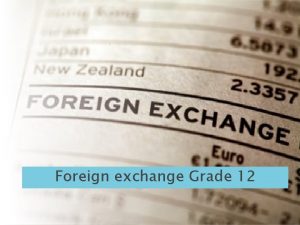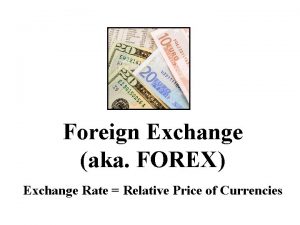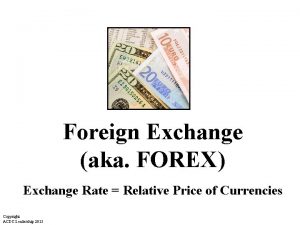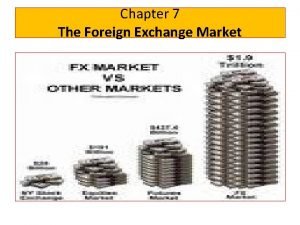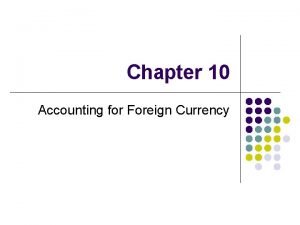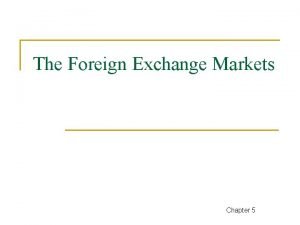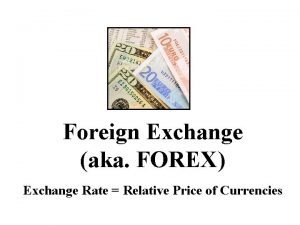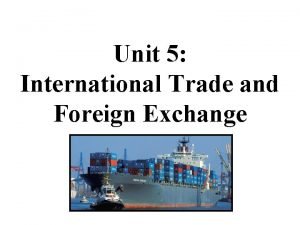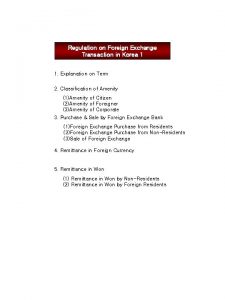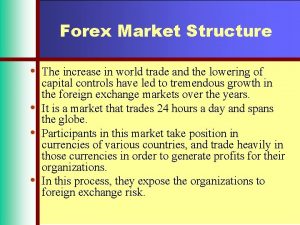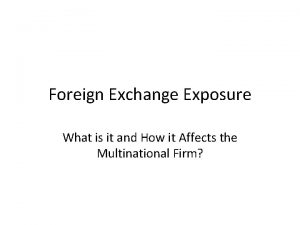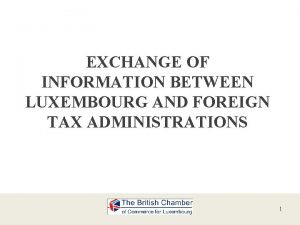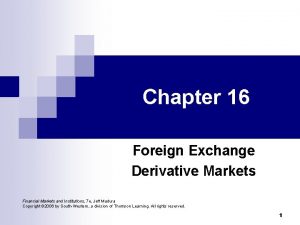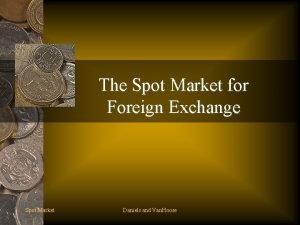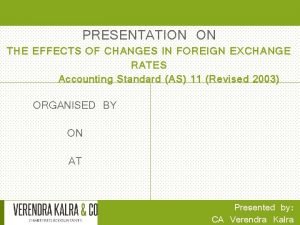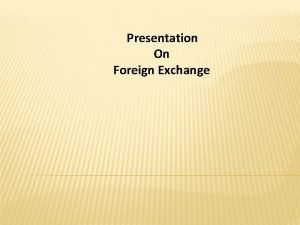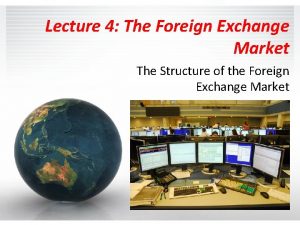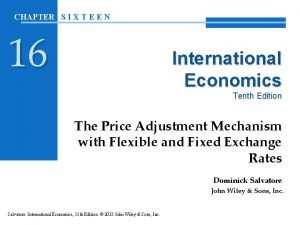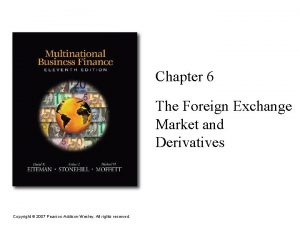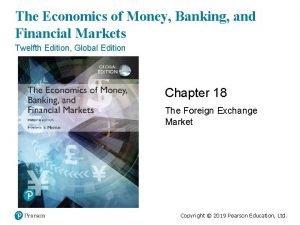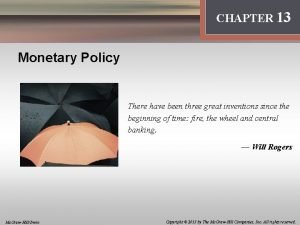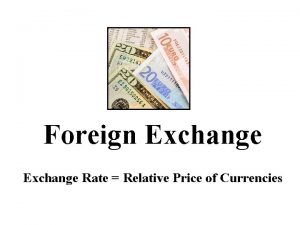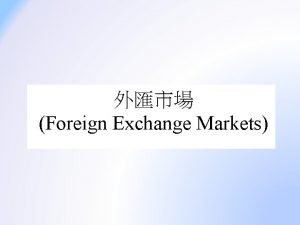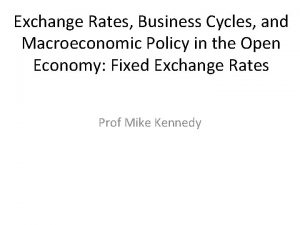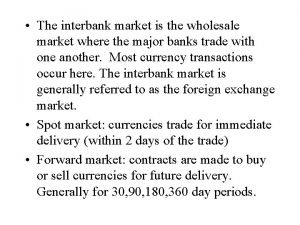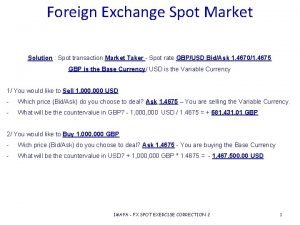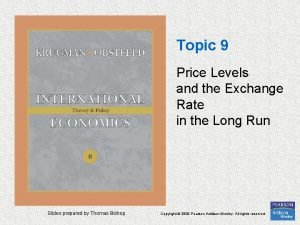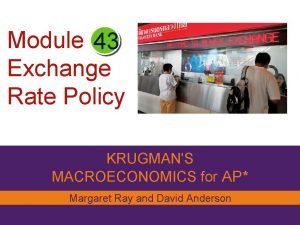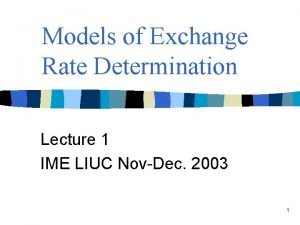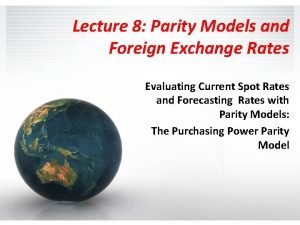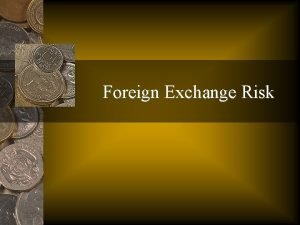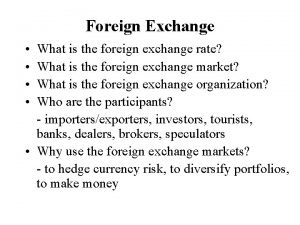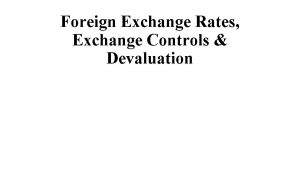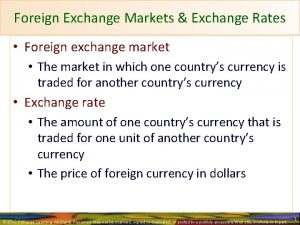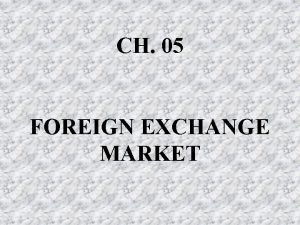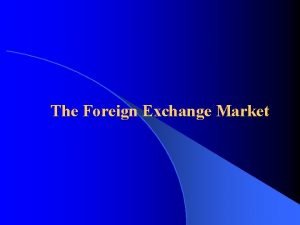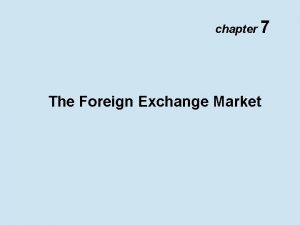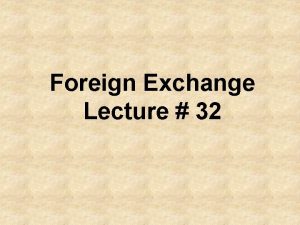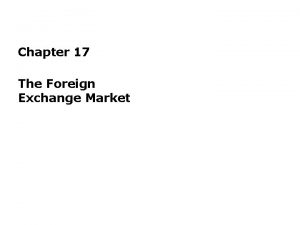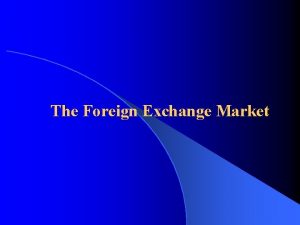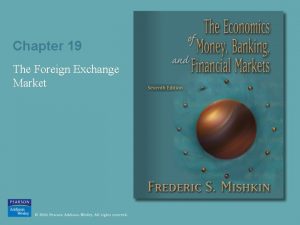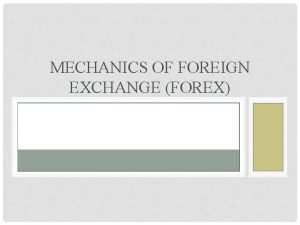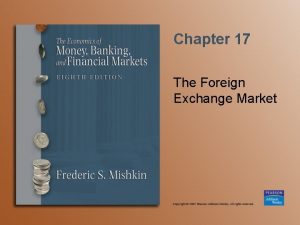FOREIGN EXCHANGE RATE 1 INTRODUCTION The exchange rate
























































































- Slides: 88

FOREIGN EXCHANGE RATE 1

INTRODUCTION • The exchange rate is the price of one currency in terms of another. • Exchange rate affects the economy and our daily lives through different channels. 2

INTRODUCTION • There are two different exchange rate systems: – fixed exchange rate system – and floating exchange system. • In the fixed exchange rate system, exchange rate is decided by the government; in the floating exchange rate system it is determined in the market. 3

INTRODUCTION • Today, most of the countries implement floating exchange rate system. • In this lesson we will examine how the floating exchange rate system is working and how exchange rate is determined in the foreign exchange market. 4

INTRODUCTION • When a currency increases in value relative to another, it appreciates; when it falls in value, it depreciates. 5

FOREIGN EXCHANGE MARKET 6

FOREIGN EXCHANGE MARKET • Most of the countries of the world have their own currencies. • Trade and capital movements between countries involve the mutual exchange of different currencies. 7

FOREIGN EXCHANGE MARKET • For example, when a Turkish firm buys foreign goods, services, or assets, Turkish liras must be exchanged foreign currency. • Trading of currencies takes place in the foreign exchange market. • Transactions conducted in the foreign exchange market determine the exchange rates. 8

Why Are Exchange Rates Important? 9

Why Are Exchange Rates Important? • Exchange rates are important because they affect the relative prices of domestic and foreign goods and assets. 10

Why Are Exchange Rates Important? For example: • The lira price of German goods to a Turk is determined by the interaction of two factors: – the price of German goods in euro – and the euro/lira exchange rate. 11

Why Are Exchange Rates Important? • Suppose that a Turk decides to buy a German car. 12

Why Are Exchange Rates Important? • If the price of the car in Germany is 20, 000 euro and the exchange rate is 8. 00 liras, the car will cost 160, 000 liras in Turkey (=8. 00 x 20, 000). • If the exchange rate were 9. 00 liras per euro, the lira cost of the same car would be 180, 000 liras (=9. 00 X 20, 000). 13

Why Are Exchange Rates Important? • The result is that, appreciation of euro makes the price of German goods in Turkey more expensive. • Appreciation of euro, however, makes the price of Turkish goods in Germany less expensive. 14

Why Are Exchange Rates Important? • At an exchange rate of 8. 00 liras per euro, a shirt priced at 180 liras in Turkey, costs to a German 22. 50 euro (=180/8. 00). • If the exchange rate increases to 9. 00 liras per euro, the shirt will cost only 20 euro (=180/9. 00). 15

Why Are Exchange Rates Important? • In contrast, a depreciation of the euro lowers the cost of German goods in Turkey but raises the cost of Turkish goods in Germany. 16

Why Are Exchange Rates Important? • If the euro drops in value to 7. 00 liras, the cost of the German car will be 140, 000 liras (=20, 000 X 7. 00) instead of 160, 000 liras, and the Turkish shirt will cost the Germans 25. 71 euro (=180/7. 00) rather than 22. 50 euro. 17

Why Are Exchange Rates Important? • The conclusion: When a country’s currency appreciates, the country’s goods abroad become more expensive and foreign goods in that country become cheaper (holding domestic prices constant in the two countries). 18

Why Are Exchange Rates Important? • Conversely, when a country’s currency depreciates, its goods abroad become cheaper and foreign goods in that country become more expensive. 19

Why Are Exchange Rates Important? • Appreciation of a currency can make it harder for domestic manufacturers to sell their goods abroad and can increase competition at home from foreign goods, because they cost less. 20

How is Foreign Exchange Traded? 21

How is Foreign Exchange Traded? • National currencies are not traded at a particular place. 22

How is Foreign Exchange Traded? • Instead, the foreign exchange market is organized as an over-the-counter market in which many dealers stand ready to buy and sell national currencies. • The market is very competitive and functions like a centralized market because these dealers are in constant contact. 23

How is Foreign Exchange Traded? • Talking about buying and selling currencies in foreign exchange markets does not necessarily mean exchanging lira bills for another national currency notes. • Rather, most trades involve the buying and selling of bank deposits denominated in different currencies. 24

How is Foreign Exchange Traded? • So, when we say that a bank is buying dollars in the foreign exchange market, we mean that the bank is buying deposits denominated in dollars. 25

How is Foreign Exchange Traded? • Trades in the foreign exchange market consist of transactions in big amounts. • Prices in foreign exchange markets and retail markets are not the same. • Retail prices of foreign currencies in a national currency are higher than wholesale, when we buy foreign exchange. 26

How is Foreign Exchange Traded? • There are two kinds of exchange rate transactions: spot transactions and forward transactions. • Spot transactions involve the immediate exchange of currencies. • Forward transactions involve the exchange of currencies at some specified future date. 27

How is Foreign Exchange Traded? • The spot exchange rate is the exchange rate for the spot transaction, and the forward exchange rate is the exchange rate for the forward transaction. 28

HOW ARE EXCHANGE RATES DETERMINED IN THE MARKET? 29

How are exchange rates determıned in the market • Exchange rates are determined by the interaction between the supply and demand of national currencies. 30

How are exchange rates determıned in the market • One peculiarity of the foreign exchange markets is that, one currency is exchanged for another. • Therefore, demanding a foreign currency means supplying the national currency. 31

How are exchange rates determıned in the market • There are two different approaches to explain how exchange rate is determined in the market: – Purchasing power parity approach (PPP) – and uncovered interest parity approach (UIP). 32

How are exchange rates determıned in the market • In the PPP approach, foreign currencies are demanded mainly for the purchase of foreign goods and services. • In UIP approach, foreign currencies are demanded mainly for the purchase of foreign assets. 33

PURCHASING POWER PARITY APPROACH (PPP) 34

Purchasing Power Parity Approach (PPP) • PPP approach is based on the law of one price. • So, before the explanation of PPP approach, we will explain the law of one price. 35

Law of One Price 36

Law of One Price • The law of one price states that if countries produce an identical good, and transportation costs and trade barriers are very low, the price of the good should be the same in all countries. 37

Law of One Price • Suppose that a Turkish shirt costs 160 liras and an identical German shirt costs 20 euro. 38

Law of One Price • For the law of one price to hold, the exchange rate between the lira and the euro must be 8. 00 liras per euro so that one Turkish shirt sells for 20 euro in Germany (the price of German shirt) and one German shirt sells for 160 liras in Turkey (the price of Turkish shirt). 39

Law of One Price • If the exchange rate were 4. 00 liras per euro, German shirt would sell for 80 liras in Turkey or half the price of Turkish shirt, and a Turkish shirt would sell for 40 euro in Germany, twice the price of German shirt. 40

Law of One Price • Because Turkish shirt would be more expensive than German shirt in both countries and is identical to German shirt, the demand for Turkish shirt would go to zero. 41

Law of One Price • Given a fixed lira price for the Turkish shirt, the resulting excess supply of Turkish shirt will be eliminated only if the exchange rate rises to 8. 00 liras per euro, making the prices of the Turkish shirt and German shirt the same in both countries. 42

Theory of Purchasing Power Parity (PPP) 43

Theory of Purchasing Power Parity (PPP) • The theory of purchasing power parity (PPP) states that exchange rate between any two currencies will change in accordance with the changes in the relative price level of the two countries. • It is simply an application of the law of one price to national price levels rather than to individual prices. 44

Theory of Purchasing Power Parity (PPP) • Suppose that the euro price of German shirt rises by 20% to 24 euro while the lira price of the Turkish shirt remains constant at 160 liras. • For the law of one price to hold, the exchange rate must fall to 6. 67 liras per euro (= TL 160/24 euro) • That means a 20% appreciation of the lira. 45

Theory of Purchasing Power Parity (PPP) • Applying the law of one price to the price levels in the two countries produces theory of PPP. • This theory argues that if the German price level rises by 20% relative to the Turkish price level, the lira will appreciate by 20% against euro. 46

Theory of Purchasing Power Parity (PPP) • As our Turkish/German example demonstrates, theory of PPP suggests that if one country’s price level rises relative to another’s, its currency should depreciate by the same percentage (the other country’s currency should appreciate). 47

Theory of Purchasing Power Parity (PPP) • While PPP theory provides some guidance to the long-run movement of exchange rates, it is not perfect and in the short run is a particularly poor predictor. • Now, we will see why the PPP theory is not a good predictor of the exchange rate. 48

Why the Theory of PPP Cannot Fully Explain Exchange Rates 49

Why the PPP Theory Cannot Fully Explain Exchange Rates • The PPP theory concludes that exchange rates are determined solely by changes in relative price levels. • This conclusion rests on the assumption that – all goods are identical in both countries – and that transportation costs and trade barriers are very low. 50

Why the PPP Theory Cannot Fully Explain Exchange Rates • When this assumption is true, the law of one price states that the relative prices of all these goods (that is, the relative price level between the two countries) will determine the exchange rate. 51

Why the PPP Theory Cannot Fully Explain Exchange Rates • First of all, the assumption that goods are identical is not reasonable, and their prices do not have to be equal. 52

Why the PPP Theory Cannot Fully Explain Exchange Rates • Secondly, the PPP theory does not consider that many goods and services (whose prices are included in a measure of a country’s price level) are not traded across borders. • Housing, land, and services such as restaurant meals, and haircuts are not traded goods. 53

Why the PPP Theory Cannot Fully Explain Exchange Rates • So, even though the prices of these items might rise and lead to a higher price level relative to another country, there would be little direct effect on the exchange rate. 54

Why the PPP Theory Cannot Fully Explain Exchange Rates • Thirdly, transportation costs are an important factor influencing the prices of imported goods, and there are trade barriers. • Barriers to free trade such as tariffs and quotas can affect the exchange rate. (taxes on imported goods; restrictions on the quantity of foreign goods that can be imported) 55

Why the PPP Theory Cannot Fully Explain Exchange Rates • Suppose that Turkey increases its tariff or puts a lower quota on German shirts. 56

Why the PPP Theory Cannot Fully Explain Exchange Rates • These increases in trade barriers raise the demand for Turkish shirts, and the lira tends to appreciate because Turkish shirts will still sell well even with a higher value of the lira. • The result: Increasing trade barriers cause a country’s currency to appreciate in the long run. 57

Why the PPP Theory Cannot Fully Explain Exchange Rates • Fourthly, and most importantly, the demand supply of foreign exchanges are not resulted only from exports and imports of goods and services. • Most of demand foreign currencies is resulted from the demand foreign assets, especially financial assets. 58

Why the PPP Theory Cannot Fully Explain Exchange Rates • While the turnover in the international foreign exchange markets is more than $6 trillion per day in 2019, total value of global trade in goods and services, in the same year, is about $25 trillion per year. 59

Why the PPP Theory Cannot Fully Explain Exchange Rates • That means, the average daily foreign exchange demand for trade in goods and services constitutes only about one percent of the total foreign exchange demand. 60

Why the PPP Theory Cannot Fully Explain Exchange Rates • PPP approach does not consider most of the demand foreign exchanges; that is, the demand foreign assets. • Now, we continue with the UIP approach, which is based mainly on the foreign asset demand. 61

UNCOVERED INTEREST PARITY APPROACH (UIP) 62

Uncovered Interest Parıty Approach (UIP) • In the uncovered interest parity approach, the exchange rate is the price of one asset in terms of another. • Thus, the natural way to investigate the determination of exchange rates is through an asset market approach that relies heavily on theory of asset demand. 63

Uncovered Interest Parıty Approach (UIP) • The PPP theory emphasizes the role of import and export demand for national currencies in exchange rate determination. 64

Uncovered Interest Parıty Approach (UIP) • For the asset market approach, however, the currency flows created by international trade are not decisive over shorts periods, because these transactions are quite small relative to the amount of international capital movements at any given time. 65

Uncovered Interest Parıty Approach (UIP) • Thus, foreign exchange transactions related to international capital movements play a much greater role in exchange rate determination than the demand for exports and imports does. 66

Demand Foreign Assets 67

Demand Foreign Assets • There is capital mobility in the world. • Foreigners can easily purchase Turkish assets, and Turks can easily purchase foreign assets. 68

Demand Foreign Assets • In this analysis, Turkey is the home country and bonds denominated in liras are Turkish assets; euro is the foreign country’s currency and euro bonds are foreign assets. 69

Demand Foreign Assets • For simplicity, we assume that the maturity, risk and liquidity structures of domestic and foreign bonds are the same. • That means, domestic and foreign bonds are perfect substitutes* (that is, equally desirable). 70

Demand Foreign Assets • Thus, the most important factor affecting the demand for lira bonds and euro bonds is the expected return on these assets relative to each other. 71

Demand Foreign Assets • When capital is mobile and when bonds are perfect substitutes, if the expected return on lira bonds is above that on euro bonds, both foreigners and Turks will want to hold only lira bonds and will be unwilling to hold euro bonds. 72

Demand Foreign Assets • Conversely, if the expected return on euro bonds is higher than on lira bond, both foreigners and Turks will not want to hold any lira bonds and will want to hold only euro bonds. 73

Demand Foreign Assets • The increase in demand for lira bonds will result in an increase in the demand for lira and an increase in the supply of euro, leading an appreciation in lira and a depreciation in euro, and vice versa. 74

Demand Foreign Assets • This change in the exchange rate will continue until the expected return of lira and euro bonds in terms of the same currency will become equal. 75

Demand Foreign Assets • The exchange rate which equates the expected returns of lira bonds and euro bonds is called the Interest parity. 76

Interest Parity Condition 77

Interest Parity Condition • To understand the interest parity, think about a person living in Turkey. 78

Interest Parity Condition • Suppose that this person saved 100 liras and has two options: – Purchasing bonds in lira issued by the Turkish Treasury – and purchasing bonds in euro issued by the German Treasury, both are one-year maturity bonds. 79

Interest Parity Condition • If this person prefers the Turkish bond, the income she will receive one year later will be 100(1+i. D) lira * where (i. D) interest rate on lira bonds. 80

Interest Parity Condition • If she prefers German bonds, she will buy (100/Et) euro at the current exchange rate (Et) first, and then purchase euro bonds of the same value. • At the maturity date, she will have (100/Et)(1+i. F) euro * where (i. F) is the interest rate on euro bonds. 81

Interest Parity Condition • To compare the returns of both alternatives we need to know the expected exchange rate between euro and lira at the maturity date and calculate lira value of income received from euro bonds. 82

Interest Parity Condition • If we denote the expected exchange rate as lira revenue of euro bond will be, (1+i. F)( )* • Under the assumed market conditions the expected returns of the Turkish bonds and German bonds should be equal. 83

Interest Parity Condition • 84

Interest Parity Condition • From the equation above, the interest parity is calculated as Et = (1) 85

Interest Parity Condition • Equation 1 tells that, under ceteris paribus assumption: ü there is a negative relationship between the current exchange rate(Et) and interest rate on domestic bonds (i. D), ü there is a positive relationship between the current exchange rate (Et) and the interest rate on foreign bonds (i. F), ü and there is a positive relationship between the current exchange (Et) rate and expected exchange rate( ). 86

Interest Parity Condition • It should be noted that the relationship between the exchange rate and other variables included in Equation 1 is valid only under ceteris paribus assumption and if risk structures of the bonds are not different. 87

Interest Parity Condition • Differences in risk structures should be considered when evaluating the predictive power of the uncovered interest parity theory. 88
 Addison currency exchange
Addison currency exchange Too foreign for home
Too foreign for home Forex trading process
Forex trading process Exchange rate grade 12
Exchange rate grade 12 Foreign exchange shifters
Foreign exchange shifters Forex market shifters
Forex market shifters Functions of foreign exchange market
Functions of foreign exchange market Fx accounting
Fx accounting Objective of foreign exchange
Objective of foreign exchange Xlri exchange program
Xlri exchange program Foreign exchange shifters
Foreign exchange shifters Unit 5 international trade
Unit 5 international trade Foreign exchange transaction regulation korea
Foreign exchange transaction regulation korea Hsbc forex rates
Hsbc forex rates Forex market growth
Forex market growth Types of foreign exchange exposure
Types of foreign exchange exposure Foreign exchange luxembourg
Foreign exchange luxembourg Foreign exchange means
Foreign exchange means Foreign exchange derivative
Foreign exchange derivative Spot market in foreign exchange market
Spot market in foreign exchange market Integral foreign operation meaning
Integral foreign operation meaning Foreign exchange market slideshare
Foreign exchange market slideshare Exchange rate maths literacy grade 12
Exchange rate maths literacy grade 12 Structure of foreign exchange market
Structure of foreign exchange market Foreign exchange market features
Foreign exchange market features Fema
Fema Stability of foreign exchange market
Stability of foreign exchange market Types of exchange rate
Types of exchange rate Foreign exchange market example
Foreign exchange market example Wise foundation
Wise foundation Foreign exchange market graph
Foreign exchange market graph Foreign exchange graph
Foreign exchange graph Exchange rate graph
Exchange rate graph Foreign exchange market
Foreign exchange market Foreign exchange forward contract
Foreign exchange forward contract Foreign exchange worksheet
Foreign exchange worksheet Exchange rate graph economics
Exchange rate graph economics The interbank market in foreign exchange is where
The interbank market in foreign exchange is where Transaction exposure example
Transaction exposure example Spot transaction in foreign exchange
Spot transaction in foreign exchange Pearl exchange activity
Pearl exchange activity Gas exchange key events in gas exchange
Gas exchange key events in gas exchange Hát kết hợp bộ gõ cơ thể
Hát kết hợp bộ gõ cơ thể Ng-html
Ng-html Bổ thể
Bổ thể Tỉ lệ cơ thể trẻ em
Tỉ lệ cơ thể trẻ em Gấu đi như thế nào
Gấu đi như thế nào Chụp tư thế worms-breton
Chụp tư thế worms-breton Chúa sống lại
Chúa sống lại Các môn thể thao bắt đầu bằng tiếng bóng
Các môn thể thao bắt đầu bằng tiếng bóng Thế nào là hệ số cao nhất
Thế nào là hệ số cao nhất Các châu lục và đại dương trên thế giới
Các châu lục và đại dương trên thế giới Công của trọng lực
Công của trọng lực Trời xanh đây là của chúng ta thể thơ
Trời xanh đây là của chúng ta thể thơ Mật thư anh em như thể tay chân
Mật thư anh em như thể tay chân Phép trừ bù
Phép trừ bù Phản ứng thế ankan
Phản ứng thế ankan Các châu lục và đại dương trên thế giới
Các châu lục và đại dương trên thế giới Thể thơ truyền thống
Thể thơ truyền thống Quá trình desamine hóa có thể tạo ra
Quá trình desamine hóa có thể tạo ra Một số thể thơ truyền thống
Một số thể thơ truyền thống Cái miệng xinh xinh thế chỉ nói điều hay thôi
Cái miệng xinh xinh thế chỉ nói điều hay thôi Vẽ hình chiếu vuông góc của vật thể sau
Vẽ hình chiếu vuông góc của vật thể sau Thế nào là sự mỏi cơ
Thế nào là sự mỏi cơ đặc điểm cơ thể của người tối cổ
đặc điểm cơ thể của người tối cổ V. c c
V. c c Vẽ hình chiếu đứng bằng cạnh của vật thể
Vẽ hình chiếu đứng bằng cạnh của vật thể Phối cảnh
Phối cảnh Thẻ vin
Thẻ vin đại từ thay thế
đại từ thay thế điện thế nghỉ
điện thế nghỉ Tư thế ngồi viết
Tư thế ngồi viết Diễn thế sinh thái là
Diễn thế sinh thái là Dot
Dot Số nguyên tố là
Số nguyên tố là Tư thế ngồi viết
Tư thế ngồi viết Lời thề hippocrates
Lời thề hippocrates Thiếu nhi thế giới liên hoan
Thiếu nhi thế giới liên hoan ưu thế lai là gì
ưu thế lai là gì Khi nào hổ con có thể sống độc lập
Khi nào hổ con có thể sống độc lập Sự nuôi và dạy con của hổ
Sự nuôi và dạy con của hổ Hệ hô hấp
Hệ hô hấp Từ ngữ thể hiện lòng nhân hậu
Từ ngữ thể hiện lòng nhân hậu Thế nào là mạng điện lắp đặt kiểu nổi
Thế nào là mạng điện lắp đặt kiểu nổi Ppp exchange rate
Ppp exchange rate Cara menghitung shadow price
Cara menghitung shadow price Module 43 featured worksheet 1 fixed exchange rate policy
Module 43 featured worksheet 1 fixed exchange rate policy Ime exchange rate
Ime exchange rate Ppp theory formula
Ppp theory formula



